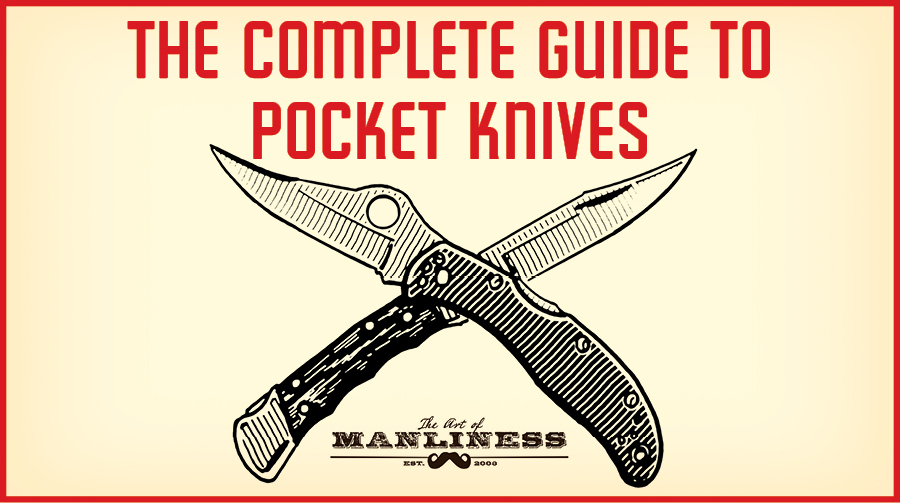
With our archives now 3,500+ articles deep, we’ve decided to republish a classic piece each Friday to help our newer readers discover some of the best, evergreen gems from the past. This article was originally published in January 2018.
I don’t collect too many things, but I do enjoy collecting pocket knives.
Ever since I was a kid, I’ve been fascinated by them. I loved rummaging through my dad’s treasure box and looking at his collection, dreaming about the day I’d own a knife of my own. That day came on Christmas when I was seven years old. In my stocking was a Boy Scout camper’s knife, the kind that had a blade and a can opener. I carried that thing with me as much as I could. My fascination with knives continues today; I love seeing what knives other men carry and checking Huckberry to see what new blades they’ve got in stock.
When I’ve talked to other men about pocket knives, they’ve shared this same fascination. What’s the appeal? For me, pocket knives are the apotheosis of form and function. They’re both aesthetically pleasing and extremely useful.
I love the look and feel of an old Case pocket knife with its handsome faux bone handle. Even the simple design of the Swiss Army knife evinces a distinct charm.
But what I like most about pocket knives is how damn handy they are. I just feel more ready to take on the world when I’ve got a knife in my pocket. And there’s something satisfying about whipping out your blade when someone asks, “Anybody got a knife on them?â€
Despite being an admirer and collector of pocket knives, I didn’t know much about them. How does the blade stay open when I’m using a knife? Why are there different blade shapes in my trapper knife? I wanted to move beyond simply thinking pocket knives were cool to really understanding their features and inner workings, so I set out on a research project.
If you find yourself in the same boat, here’s what I learned about these incredibly useful everyday carry tools.
Types of Pocket Knives
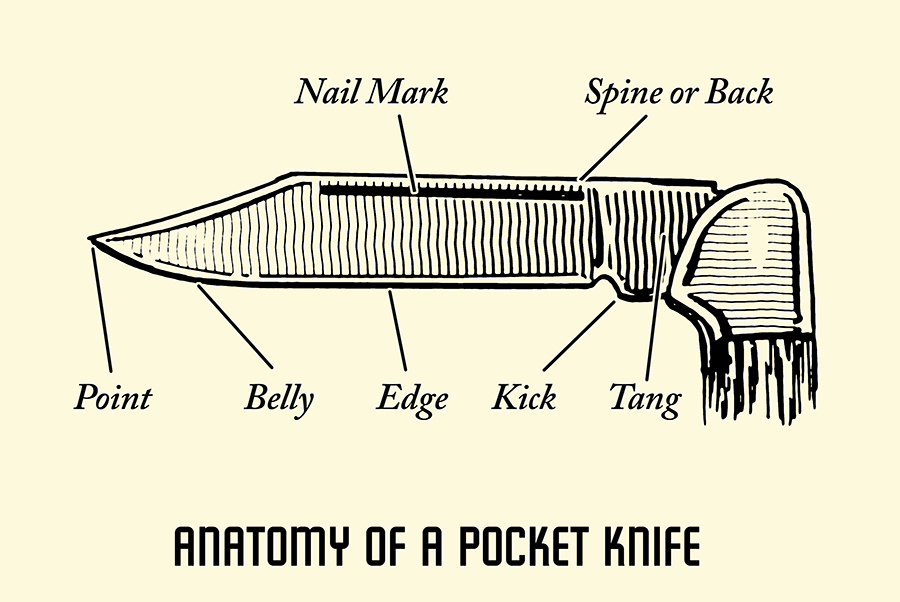
There are many different kinds of pocket knives and below we describe all the major types, as well as offer a little history as to how they came to be. Note that we mention various types of blades throughout; if you don’t know what a particular blade is, don’t worry, we’ll cover those in the next section.
Proto-Pocket Knives and the Peasant Knife
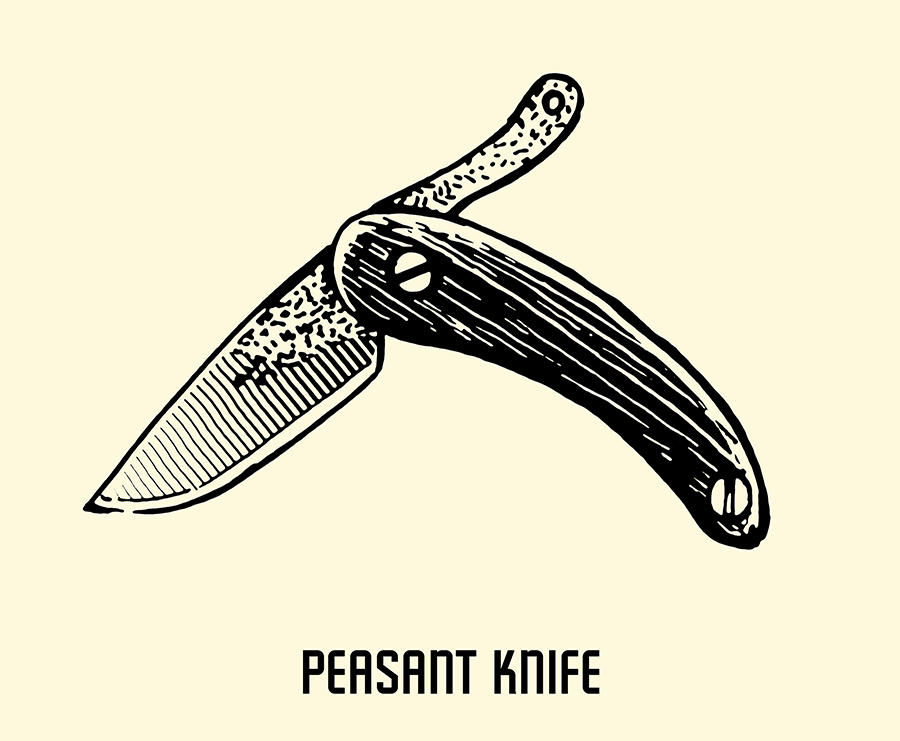
Pocket knives have been around a surprisingly long time. Well, technically these first versions weren’t actually pocket knives because pockets didn’t become a thing until the 17th century. These proto-pocket knives were small and folded which made for safe and easy carrying. Blades were made from iron or bronze and handles were made from bone or wood. A bone handle folding knife dating from 600 BC has been found in Austria while several pre-Roman folding knives have been found in Spain.
Unlike modern pocket knives, the blades of these ancient precursors didn’t lock in place. They merely swiveled on a pivot. Keeping the blade open required the handler to hold the blade with the tang. It was a lot like holding a modern straight razor.
While small folding knives existed thousands of years ago, the difficultly of producing iron made them expensive and hard to come by, precluding their becoming a common EDC item for our ancient ancestors. It wouldn’t be until the 1650s that the folding knife would become a ubiquitous tool. Around that time, Sheffield, England became the cutlery center of the world. Thanks to improvements in smelting technology, knives could be mass-produced on the cheap. One popular design was a simple folding knife with a wooden handle that farmers, herdsmen, and gardeners used. Because of the class of people who used this knife design, it became known as the peasant knife. It was also known as the penny knife because of its low price.
Like ancient proto-pocket knives, the peasant knife had no locking mechanism. To keep the blade in place, the tang of the blade would fold back into the handle, and the user would hold both the tang and the handle together. Some peasant knives just relied on the friction between the blade and the handle to keep the blade in place. The famous Opinel knife is like this.
While this set-up worked for light knife work, the chances of the blade slipping and folding back in on one’s fingers increased as the work became heavier.
Keeping the Blade Open: The Slip Joint Knife

Recognizing the danger of relying solely on friction to keep the pocket knife’s blade open, cutlers in England began experimenting with modifications that would lock the blade in place while in use and keep it closed when it wasn’t. Around 1660, folding knives with a slip joint began making an appearance.
While it appears a slip joint knife locks the blade in place when open, it doesn’t. The blade is in fact held in place by tension. Here’s how it works:
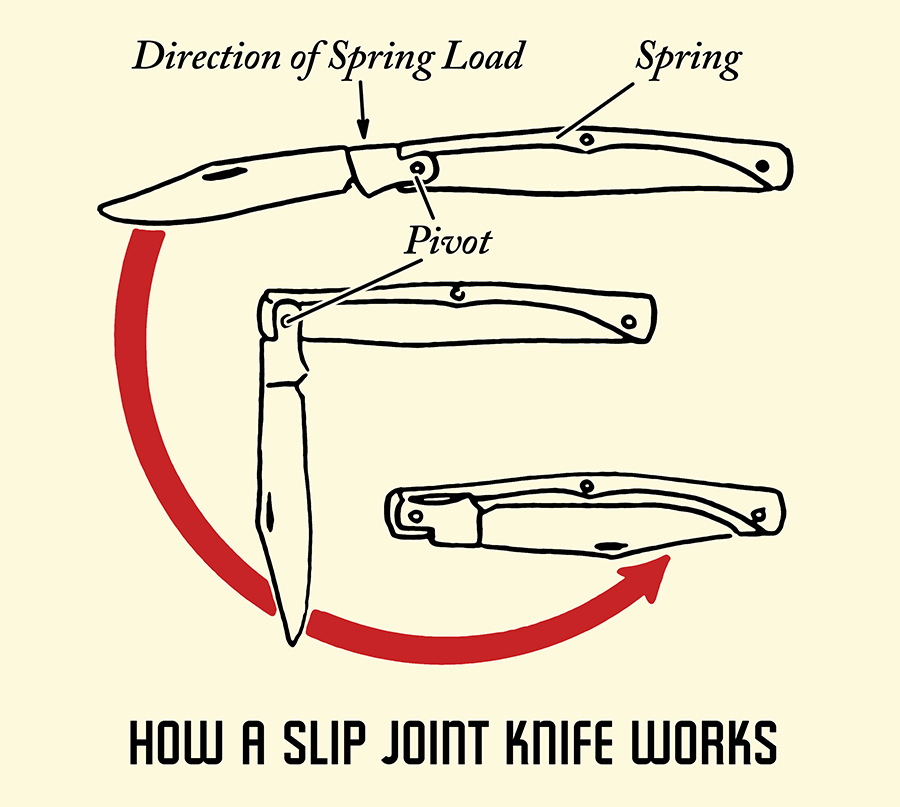
On one side of the handle, you’ve got your blade that pivots around a joint. On the other side of the handle, there’s a flat bar called a backspring. When you rotate the blade open, the blade’s tang rotates against the backspring. The pressure of the backspring against the metal keeps the knife open.
The slip joint knife became the go-to mechanism for keeping the blade of a folding knife open, and several popular pocket knife designs use it. The very first pocket knife you ever got was likely made with a slip joint, and you probably still own a slip joint knife, or three, today. Let’s take a look at a bunch of different knives within this category:
Barlow
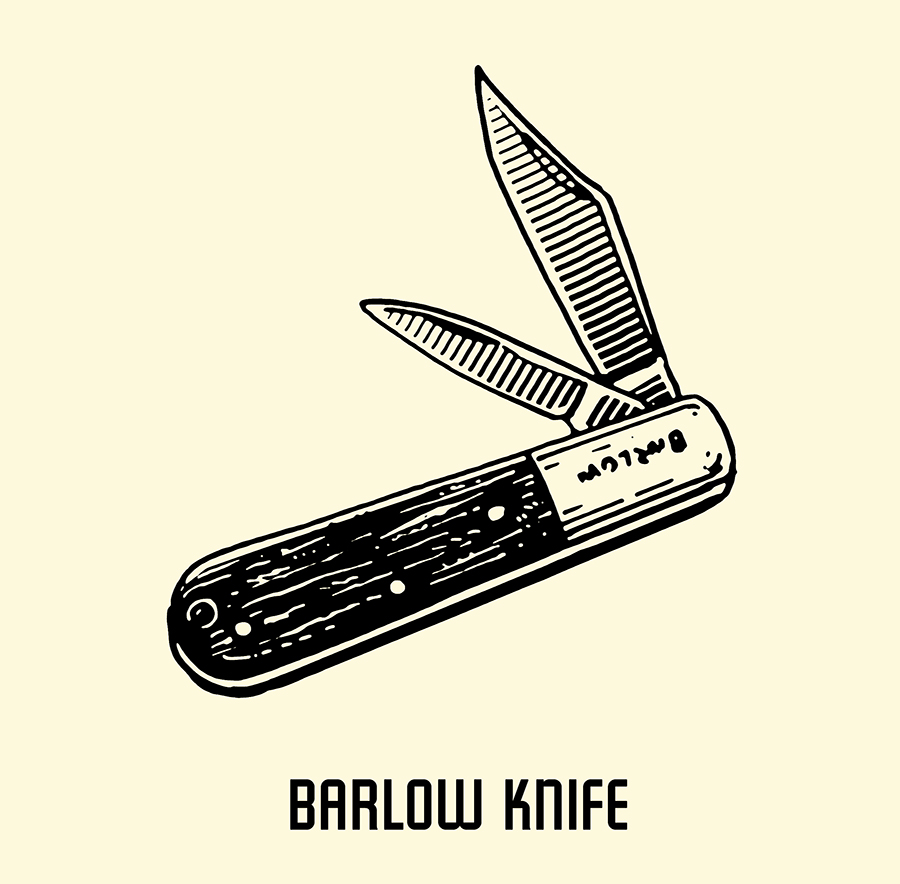
The barlow was created in England by a guy whose last name was, you guessed it, Barlow. The design features an elongated oval handle and typically a clip point and pen blade.
While the barlow was invented in England, it became a favorite pocket knife in the United States. According to Mike Yarbrough, the author of The Guy’s Guide to Pocket Knives, George Washington’s mother supposedly gifted her young son with a barlow for good behavior.
Click here to see examples of barlow knives.
Camper
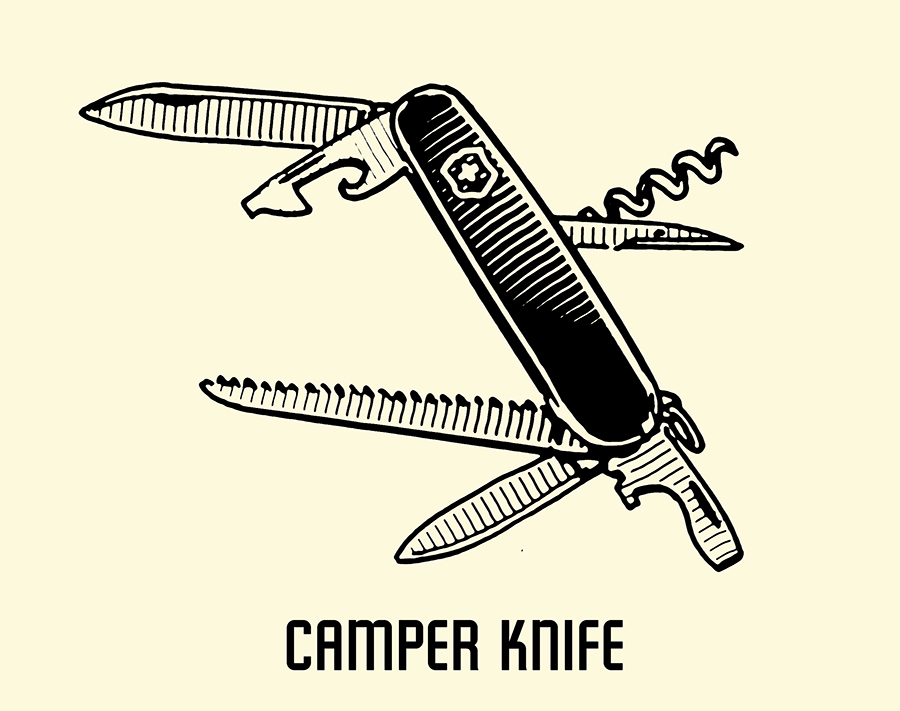
If you were ever a Boy Scout, you’ve likely owned a camper knife. Besides having different types of blades, camper knives also have various tools that could come in handy while spending time in the great outdoors: a can opener, scissors, screwdriver, etc. Also called a multi-tool knife. The Swiss Army knife is the most iconic of this type of pocket knife.
Canoe
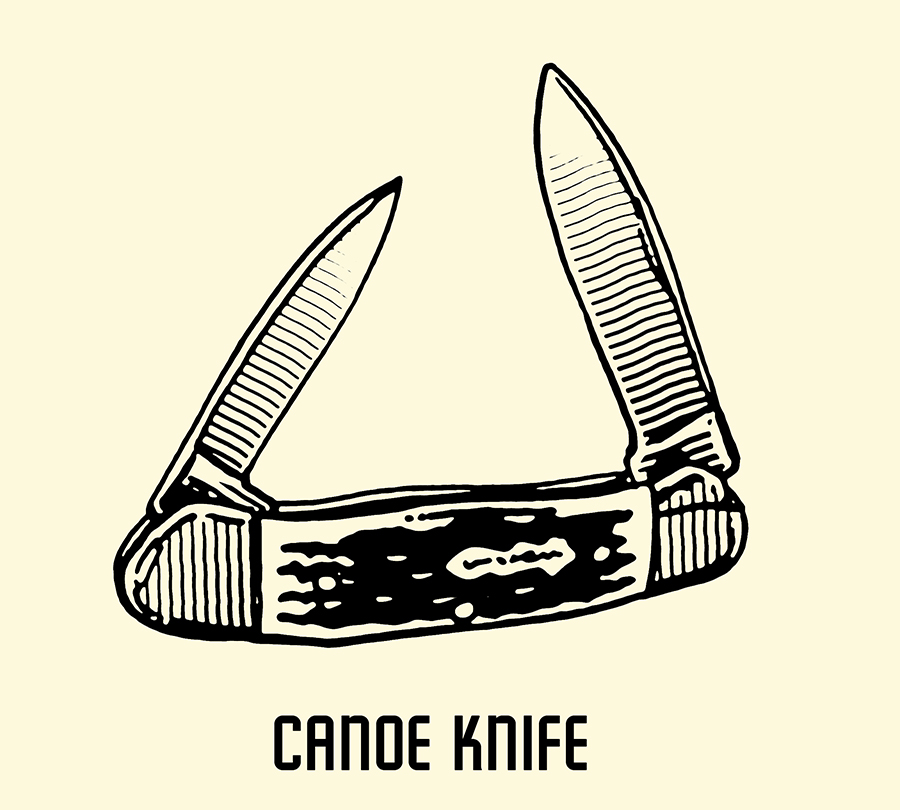
The canoe knife gets its name because it looks sort of like a canoe. It typically has two different blades. The most common combination is a drop point blade paired with a pen blade.
Click here to see examples of canoe knives.
Congress

The congress is a classic slip joint pocket knife that sports four blades — most typically the spear point, sheepsfoot, coping, and pen blades. Abe Lincoln carried a congress with him back in his rail-splitting days.
The congress supposedly got its name because all the blades form a congress, i.e., they all come together in the middle of the knife when closed.
Click here to see examples of congress knives.
Peanut
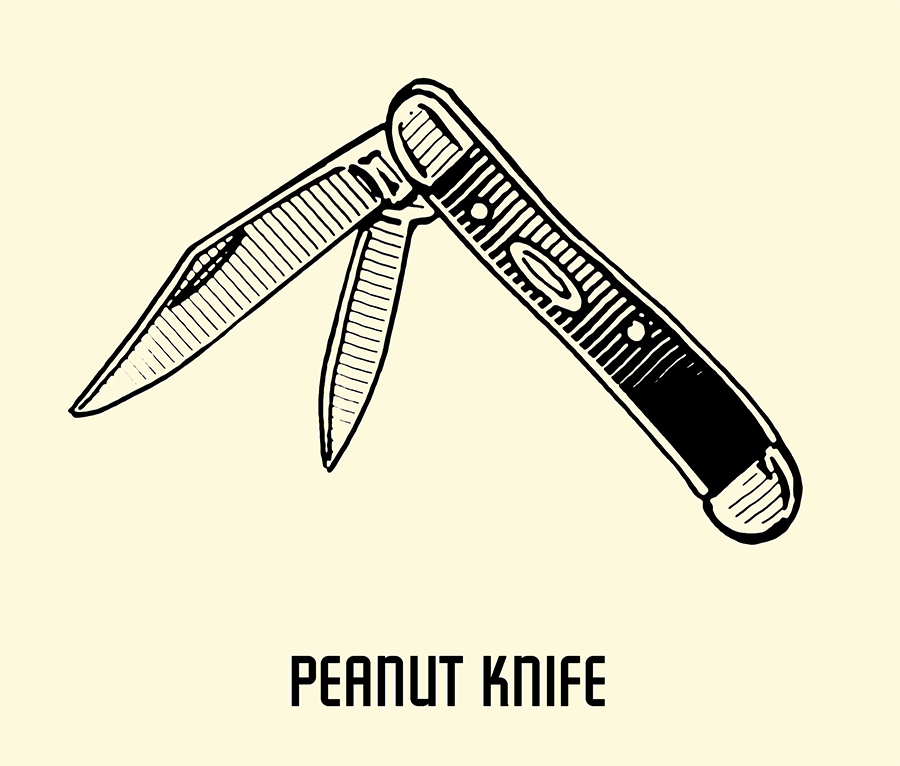
The peanut gets its name from its small size. This knife usually has two blades: a clip point and drop point on the same end.
Click here to see examples of peanut knives.
Pen
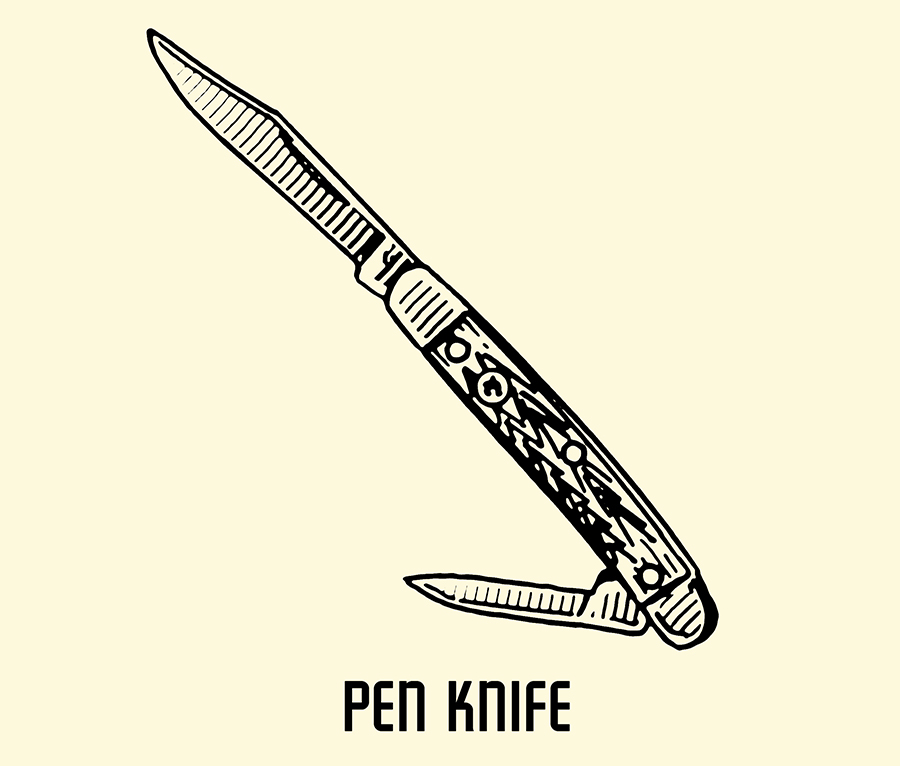
Back when people wrote with quill pens, one had to create a point on the quill before writing. To facilitate this delicate work, cutlers developed specialty pen blades. These pen knives originally had a fixed blade, but to make things even more convenient for the gentleman scholar, a folding pen knife was developed, so he’d always be ready to write when inspiration struck.
In British English, pen knife is the word for any kind of multi-bladed knife or tool. But a traditional pen knife is a small pocket knife with two blades pivoting on opposite ends, with one of them being the traditional small pen blade. It has a low profile and doesn’t stick out when in your pocket, making it an ideal pocket knife to carry when wearing a suit.
Click here to see an example of a pen knife.
Sodbuster
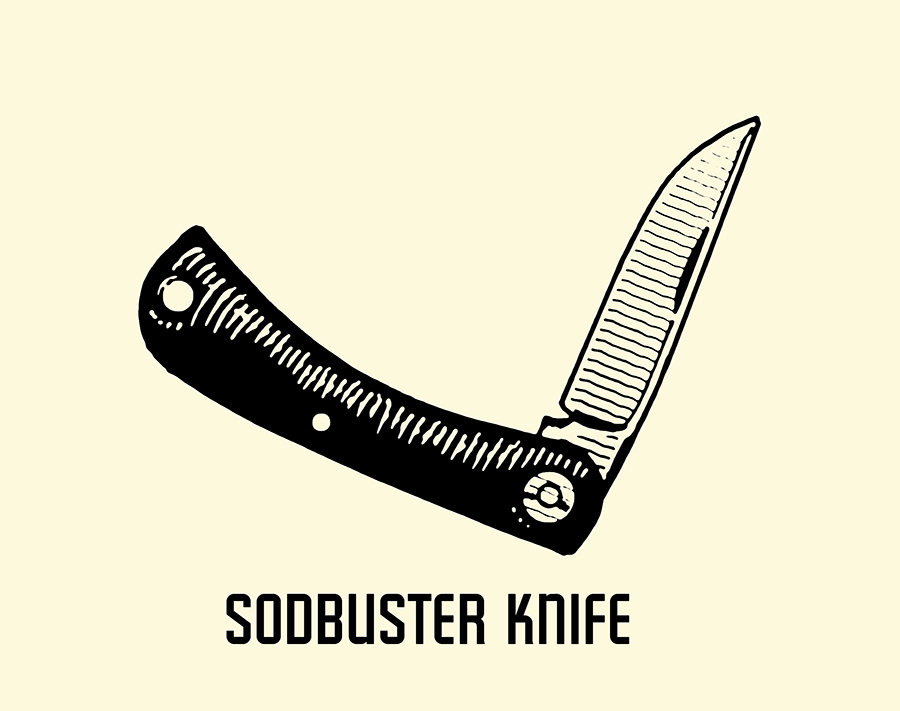
A working man’s pocket knife with a single blade. Its affordable price makes it a great “beater” knife. Consider it the modern-day peasant knife.
Click here to see examples of sodbuster knives.
Stockman
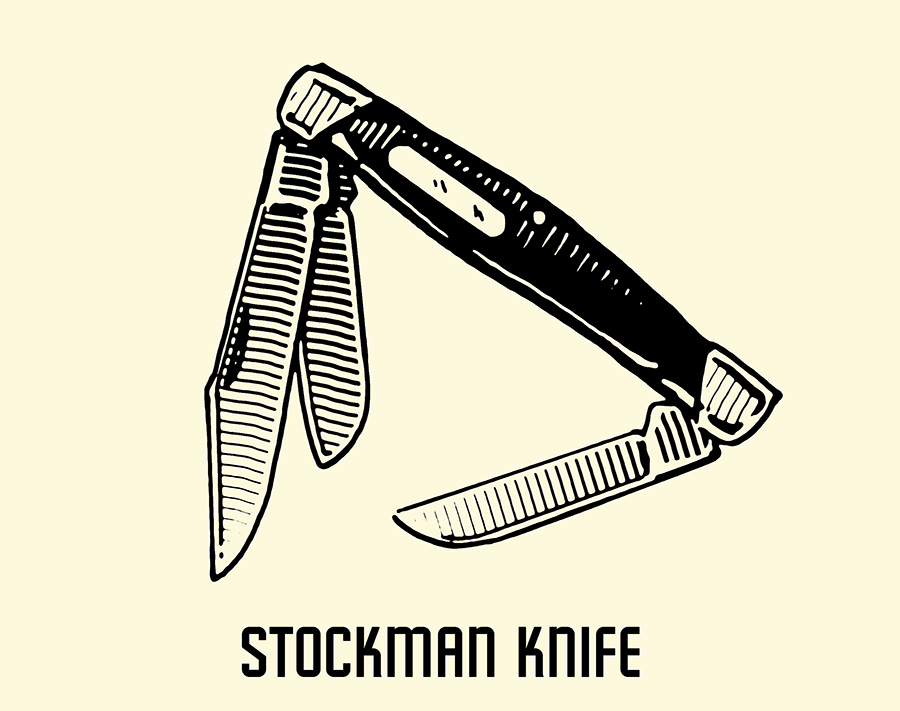
Supposedly developed for cowboys and other herdsmen, the stockman is an American classic and includes three blades: clip point, sheepsfoot, and spey. If your grandfather or father gifted you a pocket knife, chances are it was a stockman.
Click here to see examples of stockman knives.
Trapper

The trapper was developed for, well, trappers. It has two blades that trappers would find handy while skinning hides: clip point and spey. These two blades hinge on the same side.
Click here to see more examples of trapper knives.
Really Making Sure That Blade Doesn’t Close on Your Fingers: The Locking Blade
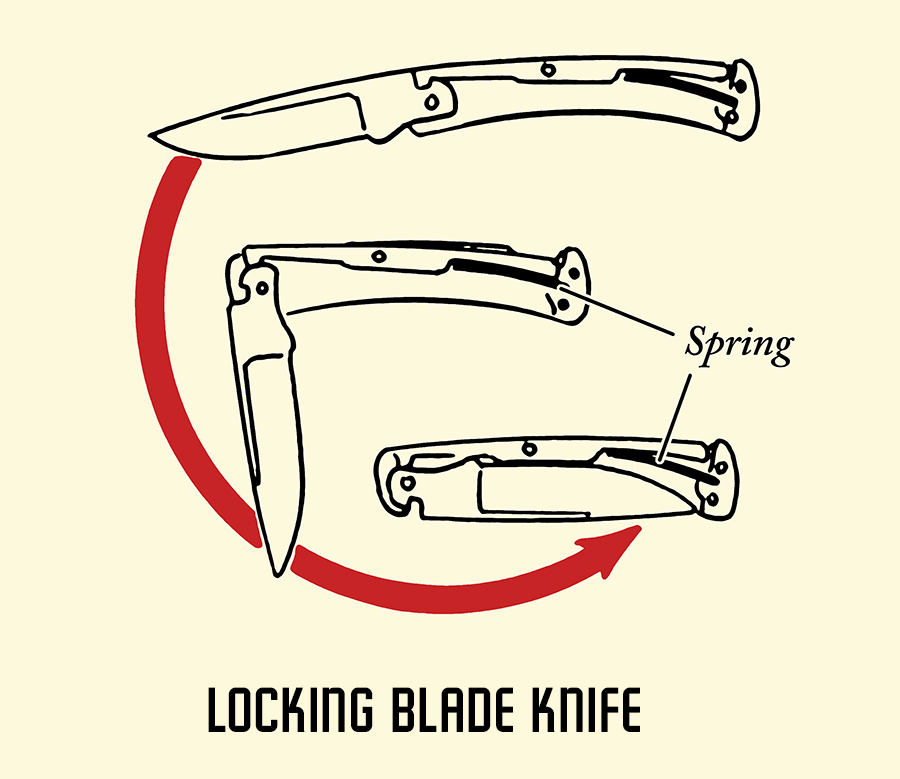
While the slip joint knife reduces the chance of a blade folding back up on you while in use, it doesn’t eliminate the risk. Around the same time that cutlers were developing the slip joint knife, they were also experimenting with lock blade folding knives. The first folding knife with a locking blade was invented in Spain in the 1600s, but it would take over 300 years for the lock blade pocket knife to become a standard fixture in the world of cutting tools.
For the eventual spread of this type of knife, we have a fella by the name of Al Buck to thank. Al owned a knife company with his father, Hoyt. During WWII, H.H. Buck and Son made fixed blade knives for American GIs. When these soldiers returned home, they went to Buck for their civilian use knives. Since civilians don’t have much need for a giant fixed blade knife on a regular basis, Al began developing a folding pocket knife that provided the stability and security of a fixed blade knife. In 1964, he introduced the world to a legend: the Buck 110 Folding Hunter locking blade knife. Also known as the Buck knife.
Like a slip joint knife, a locking blade knife has a strong backspring located along the back of the knife. But here’s the difference: on a locking blade knife, the backspring has a small hook that snaps into a corresponding notch in the blade’s heel when the blade is fully open. That locks the blade in place. To release the backspring’s hook from the blade’s heel notch, you have to apply pressure to the spring located near the end of the knife handle.
Because the Buck company never patented its knife innovation, companies around the world began to implement the design in their own folding knives.
My favorite locking blade knife is one from Santa Fe Stoneworks. It’s got dinosaur bone in the handle. How cool is that?
A Pocket Knife Fit for a Warrior: The Tactical Folding Knife
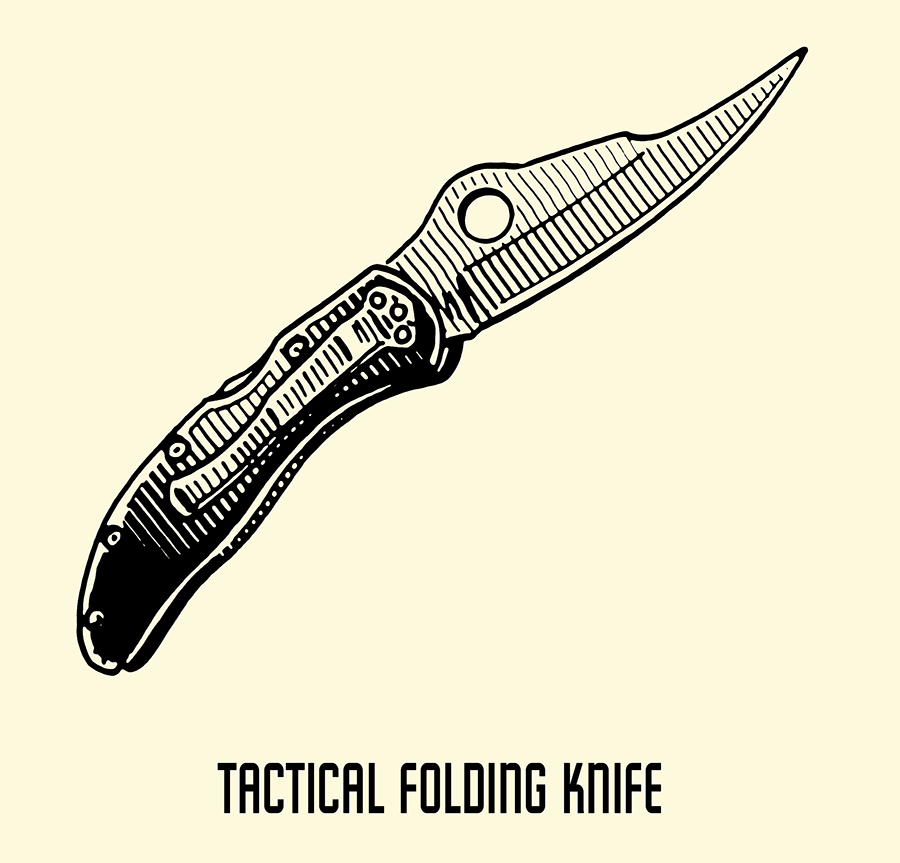
Knives are standard issue to soldiers around the world. However, when a recruit is outfitted and equipped, he’s usually given a fixed blade knife instead of a pocket knife. When you’re out on the battlefield, you can simply draw your fixed blade knife, and you’re ready for action. To ready a folding pocket knife, however, you’ve got to stick your fingernail in the nail nick of the blade while you hold it in your other hand. Since you have to use both of your hands to open the blade, pocket knives just aren’t very handy in a do-or-die situation.
To remedy this issue, knife manufacturers put a thumb stud on the blade that allows the user to open it with one hand. Instead of a thumb stud, Spyderco put a large thumb hole in the blade. To open the blade, you press the pad of your thumb into the hole and rotate it open.
Besides making the blade easier to open, knife companies made tactical folding knifes easier to get to by putting a clip on the handle. (Spyderco claims to have been the first to do that.) Instead of burying your hands in your pockets and digging around until you find your knife, a tactical folder clips to your pocket, giving you quick and immediate access to your knife.
Additionally, tactical folding knives have blades that come in handy in tactical situations. Besides being sharp and clipped, the blade will usually also have a serrated edge that can be put to use in cutting through tough material.
Click here to see more examples of tactical folding knives.
Types of Blades
Throughout this article, we’ve referred to different types of blades. If you’re a knife veteran you probably just nodded your head and continued reading. If you’re a neophyte, you probably scratched your head and felt puzzled. For the benefit of the latter, here’s a quick rundown of the types of blades you’ll find on most pocket knives and their respective uses:
Clip Point

The clip point is one of the most common blades you’ll see on pocket knives. It’s called a clip point because the final third of the back of the blade is “clipped.” The clip can be either straight or concave.
The clip point has a sharp, controllable tip that’s good for piercing. It also has lots of “belly,” or cutting edge. The disadvantage of the clip point is the tip isn’t very strong because it’s so narrow.
Drop Point
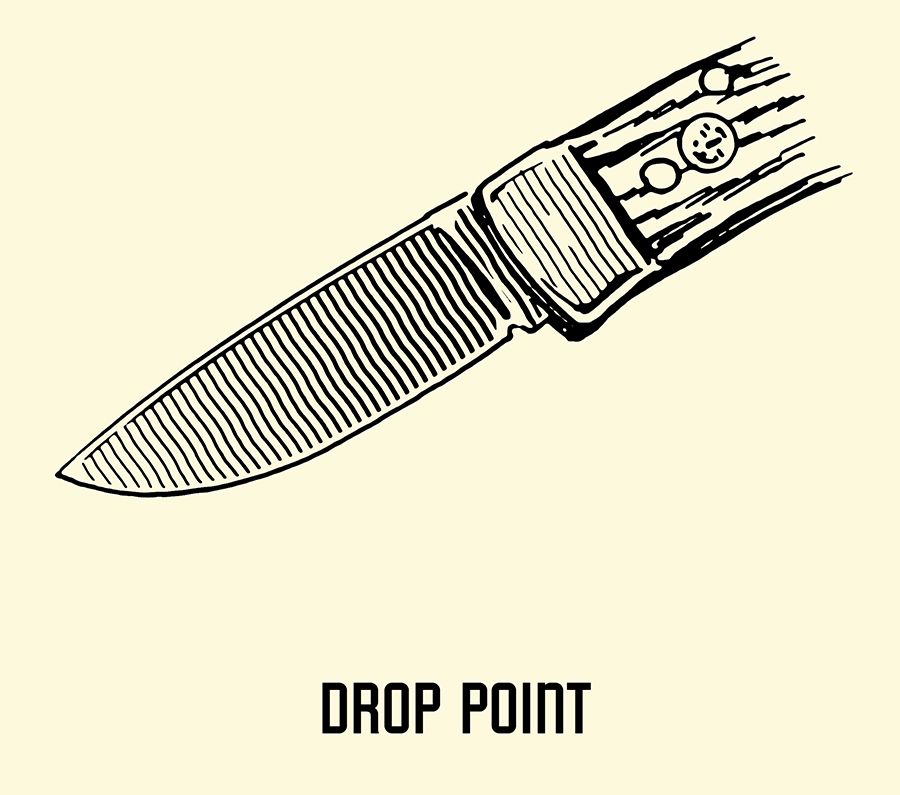
A drop point blade has a straight spine until it gets near the tip. As you get closer to the tip, the spine slopes down to meet with the bottom of the blade at a sharp point.
Drop point blades handle almost exactly like a clip point. The significant advantage of the former is that the tip is stronger than the latter because it has a broader point.
Pen Blade
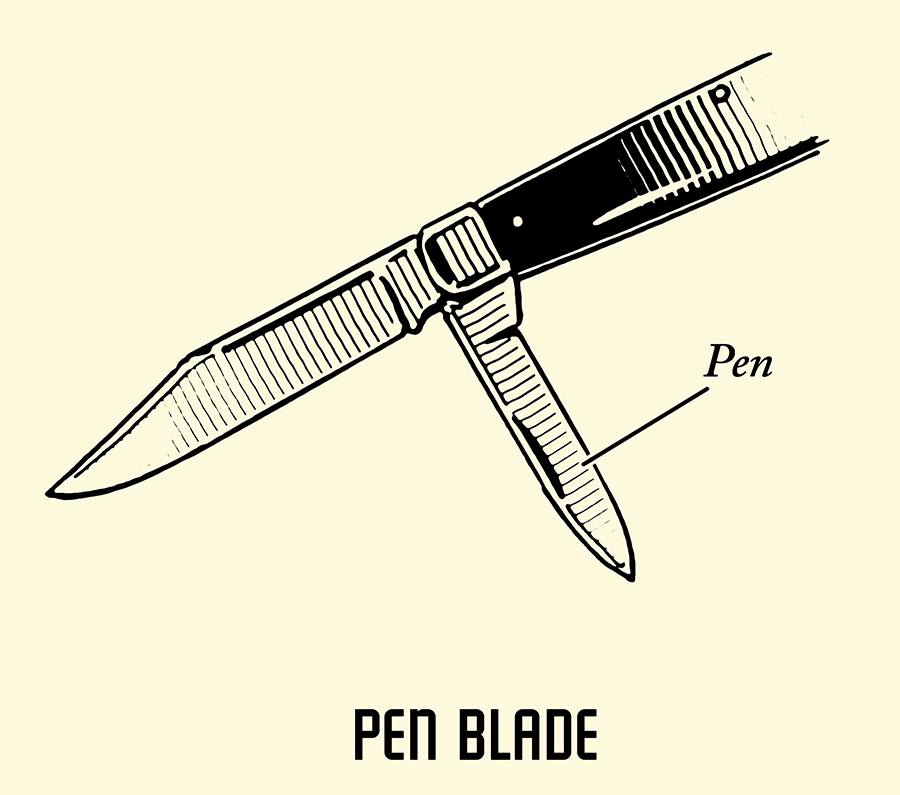
While we no longer have to sharpen quills, many multiple-blade pocket knives still include a pen blade in the mix. It’s a small blade, and not very sharp, but comes in handy for tasks that require delicate work.
Sheepsfoot
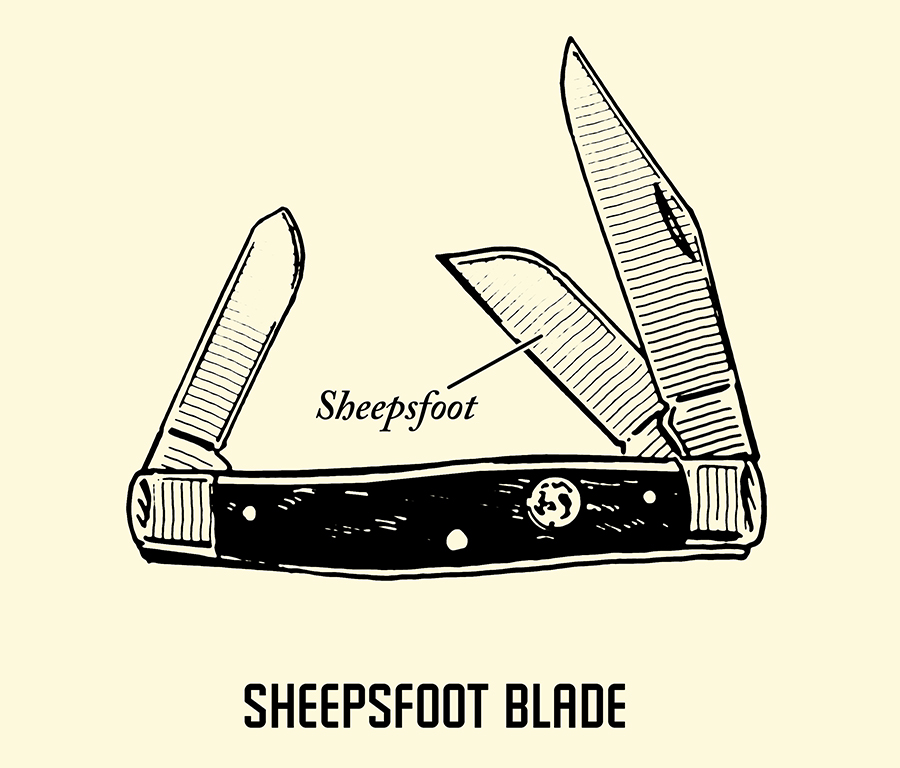
The sheepsfoot blade was designed to help shepherds trim the hooves of sheep. It has a straight dull back that curves towards the edge of the tip. The cutting edge of the blade is straight and provides a large cutting surface. While I’m sure there’s still some shepherds out there using this blade for its original purpose, it’s become a popular blade among whittlers.
Spey Blade
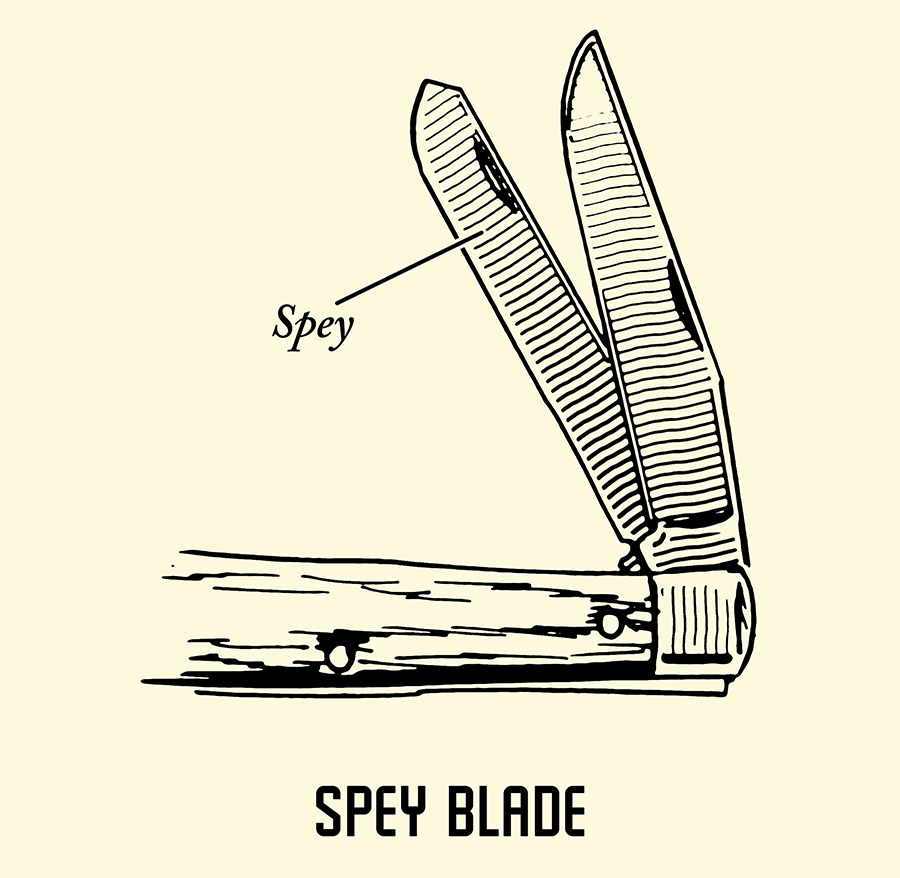
You’ll find the spey blade on stockman and trapper folding knives. It was originally designed to help castrate and spay herd animals. Somehow “spay” got turned into “spey.” At least that’s how the story goes.
The spey blade has a single sharp straight edge that curves upwards to meet a short, dull point. Spey blades can either be long or short. On trappers they tend to be long; on stockman knives, they tend to be short.
Tanto Point
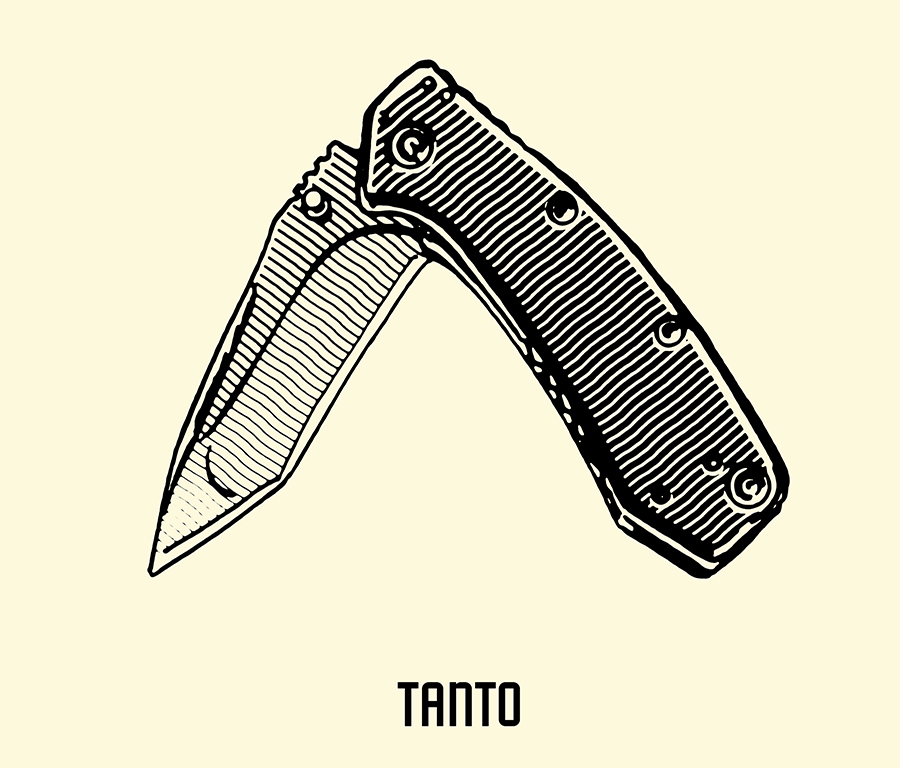
A knifepoint popularized in Japan and seen on many tactical folding knives. They’re thicker than most pocket knife blades and have a very angular point. These features make it useful for stabbing and piercing materials like Kevlar and metal.
Wharncliffe Blade

Wharncliffe blades aren’t very common, but you’ll still see them in some pocket knives. It looks very similar to sheepsfoot, but the spine meets the edge of the blade at a sharp point. It’s a popular blade among sailors.
Picking a Pocket Knife
Picking a pocket knife is like choosing clothes. It comes down to your personal needs and tastes. If you’re someone who’s doing heavy duty work day in and day out and need a knife that you can open quickly, a tactical folding knife would be in order. If you just need a knife to open the occasional package or letter, a classy looking pen knife will do the trick.
Personally, I have a large collection of pocket knives that I choose from each day. I’ve got my favorites, but they all get rotated into my EDC at least once a month. If I plan on doing a lot of heavy work that day, I clip my tactical folder in my pocket. If it’s going to be an average day, I’ll carry one of the many slip joint or locking blade knives that I have. I even have vintage ones from my dad and grandpa that I like to carry now and then. (Want to restore a vintage knife that’s been passed down to you, or one that you found at an antique store? Here’s how to do it.)
Pocket Knife Laws
In the United States, very few laws regulate what pocket knives can be owned and how they can be carried. Switchblade knives are prohibited from interstate shipment and sale, so if you’re Johnny Cade, you’re out of luck. Many states have also banned butterfly knives and gravity knives from being sold, carried, and even owned. Ten-year-old Brett thought that was a raw deal. What I would have given to have a sweet butterfly knife. I would have kept in the back pocket of my acid washed Bugle Boy jeans and worn a cool bandana around my head. Maybe even worn some leather gloves with the fingers cut off. I would have been the biggest little badass in Danforth Farms.
Yeah . . . that would have been sweet.
Anyhow, as long you as stick to your traditional pocket knife or tactical folder, you shouldn’t have much of an issue carrying a knife in the United States. Just make sure to leave your knife at home or in the car when you visit a federal or state courthouse and put it in your checked bag when flying.
For our brethren living in the U.K. and other European countries, the legality of carrying a pocket knife is much more limited. In the UK it is illegal to carry a folding knife with a blade longer than 3″. If you’ve got a knife with a longer blade, you’ve got to prove “good reason” to carry it with you in public. “Good reason” could mean the knife is required for employment or a hobby. Even if your blade is shorter than 3″, you can only carry that knife with you if it doesn’t lock. So toting a handsome Buck knife would be out of the questions for Brits.
What to Do With Your Pocket Knife
Over the years at AoM, we’ve provided a few ideas on what you can do with your pocket knife. Here’s a recap of some of that content:
Why Every Man Should Carry a Pocket Knife
How to Play Mumbley Peg
How to Whittle
Now you know a little more about the pocket knives you’ve long admired. Keep on toting one with you every day, and be sure to keep it sharp.
__________________________________
Sources
The Pocket Knife Buyer’s Guide


